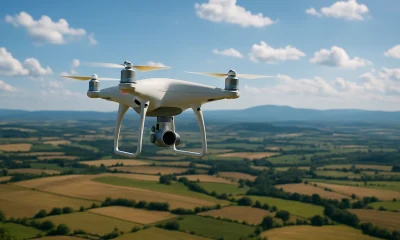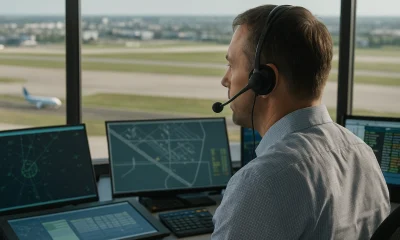- Acronym Guide
- AAM
- ABS
- AC
- ACAS
- ADS-B
- AEHF
- AFAC
- AGL
- AI
- AIM
- ALPA
- ALS
- AM
- AMA
- ANSP
- AOI
- APPI
- AUV
- AUVSI
- ARPAS-UK
- ASTM
- ATC
- ATO
- BLOS
- BVLOS
- CAA
- CAAC
- CAB
- CAP
- CASA
- CATT
- CBO
- CBR
- CBRN
- CDMA
- CDR
- CFI
- CFR
- CIR
- COA
- COMINT
- CORS
- COTP
- COTR
- CPTED
- CV
- C2
- DAA
- DAS
- DEM
- DFI
- DFS
- DGCA
- DHS
- DOD
- DPA
- DPEs
- DRG
- DRO
- DSM
- DSMX
- DSP
- DSSS
- DTM
- EASA
- EFT
- EO
- EOD
- EO/IR
- ELINT
- EMI
- ESC
- EVLOS
- eVTOLs
- FAA
- FCC
- FCS
- FHSS
- FICCI
- FLIR
- FOB
- FOV
- FPS
- FPV
- GBDAA
- GCP
- GCS
- GDPR
- GML
- GNSS
- GPS
- GSD
- GVC
- HDR
- HOGE
- IACRA
- ICAO
- ICS
- IED
- IMU
- INS
- IR
- ISA
- ISR
- ITU
- JARUS
- LAAMS
- LAANC
- LAATM
- LAI
- LAS
- LBA
- LIDAR
- LOS
- LSALT
- MAC
- MAVLink
- MLIT
- MMS
- MSL
- MTOM
- NDAA
- NCSL
- NFZ
- NIST
- NMEA
- NOTAM
- NPA
- NPRM
- NTIA
- OBIA
- OEM
- OFDM
- OGI
- OOP
- PAS
- PASM
- PAV
- PCV
- PdM
- PEC
- PIC
- PID
- PIPL
- PLD
- PM
- PN
- PPK
- PPS
- PSM
- PTZ
- PWM
- UAM
- UAOP
- UAS
- UASTM
- UAV
- UCAVs
- UHD
- UHF
- USV
- UTM
- RAIM
- RCC
- RCS
- RED
- ReOC
- RePL
- RFI
- RMS
- ROI
- RPAS
- RPC
- RTH
- RTN
- RTK
- SaR
- SAR
- SARP
- SBAS
- S.Bus
- SBIR
- SEDENA
- SfM
- SFOC
- SIGINT
- SLAM
- SMS
- SOP
- SORA
- STANAG
- STTR
- STK
- sUAS
- TCAS
- TCCA
- TFR
- TIN
- TLM
- TOF
- TP
- TPS
- TSA
- VHF
- VLOS
- VTOL
Drone Acronyms
What is NDAA (National Defense Authorization Act)?
By
Jacob StonerTable Of Contents

Definition
NDAA, or National Defense Authorization Act, is an annual piece of United States federal legislation that specifies the budget, expenditures, and policies for the U.S. Department of Defense. Within the drone industry, the National Defense Authorization Act includes compliance regulations that restrict the use of certain foreign-manufactured drone components or entire systems, especially those sourced from entities considered national security risks. It mandates that drones used in government or sensitive operations meet specific security and sourcing standards.
Usage
National Defense Authorization Act compliance is a key consideration for government drone programs, public safety agencies, critical infrastructure inspections, and contractors working with federal clients. Agencies and organizations must use drones built with approved, secure components, often certified as NDAA-compliant by the manufacturer.
Relevance to the Industry
National Defense Authorization Act affects procurement choices and operational policies across the drone sector. Many drone manufacturers now offer NDAA-compliant models to meet growing demands for secure, domestically produced (or vetted) drone technology. Non-compliance can result in disqualification from government contracts, loss of operational certification, and potential cybersecurity risks. As security concerns rise, even private-sector companies increasingly seek NDAA-compliant drones for sensitive projects.
How Does NDAA (National Defense Authorization Act) Work?
The National Defense Authorization Act impacts drone operations by enforcing security-focused standards on the manufacturing and sourcing of drone systems and components. Here’s how National Defense Authorization Act compliance works within the drone industry:
Identification of Restricted Entities
The National Defense Authorization Act specifies certain manufacturers, primarily foreign companies deemed national security risks, whose products are prohibited for use in government operations or sensitive sectors. This includes drone components like flight controllers, communication modules, GPS units, cameras, and software sourced from these entities.
Component Vetting and Certification
Drone manufacturers that wish to offer NDAA-compliant models must ensure their products are free of any restricted parts. This involves auditing the entire supply chain, replacing banned components, and sometimes redesigning hardware and software to meet NDAA standards. Compliant drones are often marketed specifically as “NDAA-compliant” to aid procurement decisions.
Procurement and Deployment
Agencies and contractors involved in government or critical operations must select drones from certified NDAA-compliant lists or verify compliance documentation before purchasing or deploying drones. Procurement officers often require proof of compliance through certifications or manufacturer assurances.
Operational Compliance and Risk Mitigation
Once deployed, the use of National Defense Authorization Act-compliant drones ensures adherence to cybersecurity protocols, protects sensitive data, and reduces the risk of potential backdoors or surveillance vulnerabilities. It also insulates organizations from regulatory penalties, contract disqualification, or loss of operational credibility.
Continuous Updates and Policy Changes
The list of restricted entities and the exact requirements can change with new legislation or executive orders. Organizations must stay informed about updates to National Defense Authorization Act compliance standards and review their drone fleets regularly to maintain eligibility for federal contracts and missions.
By ensuring that drones used in sensitive applications are built from secure and approved components, the NDAA helps safeguard critical operations from potential cybersecurity threats and foreign interference.
Example in Use
“The inspection team selected an NDAA-compliant drone model to ensure their work on the government energy project met all security and procurement standards.”
Frequently Asked Questions about NDAA (National Defense Authorization Act)
What does NDAA compliance mean for drones?
Answer:
NDAA compliance means that a drone’s components—such as flight controllers, cameras, communication systems, and software—are free from manufacturers restricted by the NDAA for national security reasons.
Typically, it ensures the drone is manufactured in friendly nations or from approved supply chains, reducing cybersecurity risks.
Who needs to use NDAA-compliant drones?
Answer:
Government agencies (local, state, federal).
Contractors performing federally funded projects.
Public safety organizations (fire, police, emergency response) using drones in mission-critical operations.
Some private companies handling critical infrastructure or sensitive data increasingly adopt NDAA-compliant fleets.
Are NDAA-compliant drones only made in the U.S.?
Answer:
Not necessarily. While many compliant drones are U.S.-manufactured, some are built with vetted international components from allied nations. The key is that none of the restricted entities’ components are used.
For examples of these acronyms visit our Industries page.
As the CEO of Flyeye.io, Jacob Stoner spearheads the company's operations with his extensive expertise in the drone industry. He is a licensed commercial drone operator in Canada, where he frequently conducts drone inspections. Jacob is a highly respected figure within his local drone community, where he indulges his passion for videography during his leisure time. Above all, Jacob's keen interest lies in the potential societal impact of drone technology advancements.
Pros
Cons
You may like


What is RED (Rapid Extraction Device) & How Does it Work?


What is IED (Improvised Explosive Device) & How Does it Work?


What is BLOS (Beyond Line of Sight) & How Does it Work?


What is ATO (Authority to Operate) & How Does it Work?


What is ALPA (Air Line Pilots Association) & How Does it Work?


What is AEHF (Advanced Extremely High Frequency)?